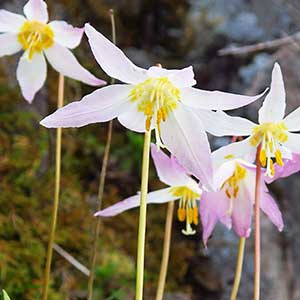Erythronium elegans
Erythronium quinaultense
Coast Range fawn lily, elegant fawn-lily
fawnlily, Olympic fawn-lily, quinault fawn-lily, quinault trout-lily
slender, 30–50 mm.
narrowly ovoid, 35–75 mm.
7–20 cm;
blade green or faintly mottled with brown or white, narrowly ovate, margins often wavy.
12–20 cm;
blade green or faintly mottled with white or brown, lanceolate to ovate, margins ± wavy.
10–30 cm.
12–25 cm.
1–2(–4)-flowered.
1–3-flowered.
tepals: inner ± white, outer ± white and tinged (often strongly) with pink, especially abaxially and along midline, becoming more generally pinkish with age, both inner and outer with yellow band at base, lanceolate to narrowly elliptic, 20–40 mm, abaxial surfaces and outer tepals often darker, inner auriculate at base;
stamens 13–22 mm;
filaments white, flattened, slightly widened, linear to lanceolate, 0.8–2 mm wide;
anthers yellow;
style white, 10–20 mm;
stigma with slender, usually recurved lobes 2–4 mm.
tepals white proximally, shading to pink at outer margins, darkest toward tips, with yellow band at base, lanceolate to narrowly ovate, 30–50 mm, inner with small auricles at base;
stamens 12–24 mm;
filaments white, flattened, slightly widened, linear to lanceolate, 1–2 mm wide;
anthers yellow;
style white, 10–18 mm;
stigma with slender, usually recurved lobes 1–5 mm.
obovoid to oblong, 2–5 cm.
oblong to obovoid, 3–6 cm.
= 48.
= 48.
Erythronium elegans
Erythronium quinaultense
Of conservation concern.
This species is endemic to the Coast Ranges of western Oregon.
(Discussion copyrighted by Flora of North America; reprinted with permission.)
Erythronium quinaultense is a tetraploid species apparently derived from hybridization between E. montanum and E. revolutum. It is known only from the southwestern Olympic Peninsula.
(Discussion copyrighted by Flora of North America; reprinted with permission.)


